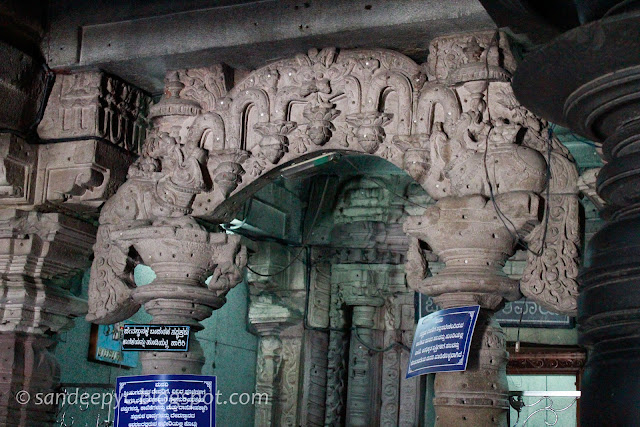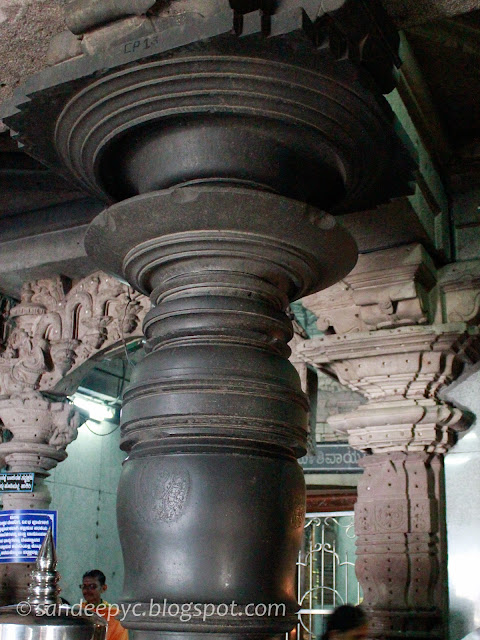Bagalkot Heritage Drive - Day 3 – Kudala Sangama
Some facts about Kudala Sangama: Kudala Sangama is in Hunagunda taluk of Bagalkot district in Karnataka state, India. It is just 8 Kms from Sangam cross on the National Highway 13. It is an important center of pilgrimage for people of the Lingayat religion. It is the place where the great social revolutionist of 12th century lord “Basavanna” was studied, preached & merged with GOD. The Krishna, Ghataprabha & Malaprabha Rivers merge here & flow east towards Srisaila (another pilgrim center) in state of Andhra Pradesh. The Aikya Mantapa or the holy Samadhi of Basavanna, the founder of the Lingayat faith along with Linga, which is believed to be self-born (Swayambhu), is situated here. The Kudala Sangama Development Board takes care of the maintenance and development of this place.
Every year during January 12th to 15th over a hundred thousand devotees gather here for the Sharana Mela held on the Occasion of Basava Kranthi Day, which was started since1988.
 |
| Shri Sangameshwar Temple |
Back to the travelogue: It was our last day of the trip & we started our day with breakfast at Kamat which was in front of the Hotel, & we first decided to visit the Basava Dharma Peetha Ashram which was just beside the Hotel.
Basava Dharma Peetha: Basava Dharma Peetha is founded by "Lingananda Swamiji". He was a legend with the legendary force behind the organization. A brave caliber, introduced Guru Basaveshwara to the whole world. At that time, people were mistaken Basaveshwara as Bull and continued worshipping it. But through the preaching (pravachana) of Lingananda Appaji, he shown the truth that Guru Basaveshwara is a historical personality who created a victory in respect to religious, spiritual, & each & every aspects.
We just walked inside the Ashram & saw a small museum of painting depicting the age of Sharana’s of 12th century & their life and what made me more interesting are the paintings of the Vachana Kranti (war for protecting the Vachana/scripts written by the saints & social reformers of Basavanna’s age)
We then proceeded towards the Sharana loka which has the statues of the Sharana’s (social reformers/saints) of the 12th century. There is a Gana linga at the center, behind these is a way towards the Dyana mandira which is underground located below the Gana linga, the place is constructed for meditation which was very ideal for its purpose as it was relatively cold and silent. There is a sculpture of Basavanna here carved out of Marble stone.
It was about 12 noon & we then proceeded towards Sangameshwara temple before shopping some books at the shop here in the Ashram.
Sangamanatha Temple & Aikya Mantapa: a 5mins drive took us to the Sangamanatha temple where the road ends. The Vachana’s composed by Basavanna are dedicated to the presiding deity here, Sangamanatha. The temple consists of a porch, navaranga & the main shrine. The door frame of the garbhagriha is richly carved with floral designs and animal figures. In the shrine is the linga famed as Sangameshvara or Sangamanatha. The temple is of Chalukyan style.
In front of the temple, in the midst of the river, is the Aikya Mantapa, Lord Basaveshwara’s holy Samadhi, a small stone Mantapa with a Shiva linga in it, & lofty cement concrete dry well has been built around it to protect it from submersion. It is here where the Krishna, Ghataprabha & Malaprabha Rivers merge.
On the other side of the river Krishna is the holy samadhi of the lady saint Neelambike, wife of Sri Basavanna. Here also a high cement concrete dry well has been built around the structure to protect it from the waters. One can take a motor boat from Sangamanatha temple or can drive through the bridge to reach the other side of the river.
It was lunch time then & we proceeded towards the Kamat hotel and had lunch and then drove towards the Basava International Centre.
Basava International Centre: it is also called as the Shatasthala the reason for which the building is divided into 6 floors. The word Shatasthala is derived from “Shat” means six and “sthala” which means stage. The tall Basava gopura is slated to house the Basava International Centre; it is more than 200ft., high symmetrical tower which is part of the Rs.450 million government project undertaken by Kudala Sangama Development Board. The structure is already being built but the interiors and the paintings are yet to be done. The structure looks very impressive and is least popular in Kudala Sangama, reason being not yet opened.
We then drove towards our last destination of our trip which was the Sabha Mantapa.
Sabha Mantapa: The colossal Sabha Bhavana. It is a spacious auditorium with a seating capacity for 6,000. The exquisite doorways on four sides named after Gangambike, Nilambike, Channabasavanna and Akka Nagamma, surround the huge grey dome in the center. As one enters the main door’s you witness the magnificent interiors of the auditorium, which houses the paintings of unique pattern of designs throughout the roof around the dome, each one of these designs are distinctive. Once you enter under the dome you find the whole place so relaxing. We spent some time relaxing inside the auditorium. Little known about the place is it is the largest open to air auditorium in India, having a huge dome at the center and doorways on 3 sides and a number of pillars holding the dome, and beside that is a circular flat roof structure which holds the center dome on a number of pillars on both the sides, beyond these pillars it is open to air making it air and light to flow to the auditorium and at the same time protecting it from the top. Also there are small openings on the top of the dome for hot air to flow outside the auditorium. This unique architectural design makes it feel colder inside even during warmer days.
It was late in the afternoon before we had to say adieu for our long heritage trip. We started around 4 pm way back to Bangalore & reached early morning on the fourth day.
This was personally my best trip till date, I leave here some of the information about the lengthy blog on Bagalkot Heritage Drive.
Sources:
How to reach: Kudalasangama & Badami are well connected by KSRTC buses from all over Karnataka & can be reached by road easily.
Nearest airport: Hubli, Belgaum. Nearest International airport is Bangalore.
Nearest railway station: Almatti, Badami
Camera Used: Canon 550D with 18-55mm lens & 55-250mm lens
Hotels & Restaurants:
- Hotel Badami Court, station road, Badami
- KSTDC Mayura Chalukya Hotel, Ramadurg Road, Badami (Veg & non Veg)
- Kamat Restaurant, Kudala Sangama(pure Veg)
- Jain Darshan Yatrinivas Hotel, Kudala Sangama
Related Posts
 |
Almatti - Bagalkot Heritage Drive - Day 1 |
 |
Aihole – Bagalkot Heritage Drive - Day 2 |
 |
Badami Banashankari Temple – Bagalkot Heritage Drive |
 |
Badami Group of Temples – Bagalkot Heritage Drive |
 |
Badami Cave Temples (1 & 2) – Bagalkot Heritage Drive |
 |
Badami Cave Temples (3 & 4) – Bagalkot Heritage Drive |
 |
Pattadakal – Bagalkot Heritage Drive - Day 2 |
 |
Pattadakal Virupaksha Temple – Bagalkot Heritage Drive |
 |
Pattadakal Papanatha Temple – Bagalkot Heritage Drive |
















































Comments
Post a Comment